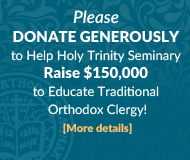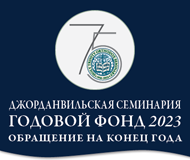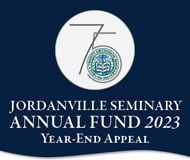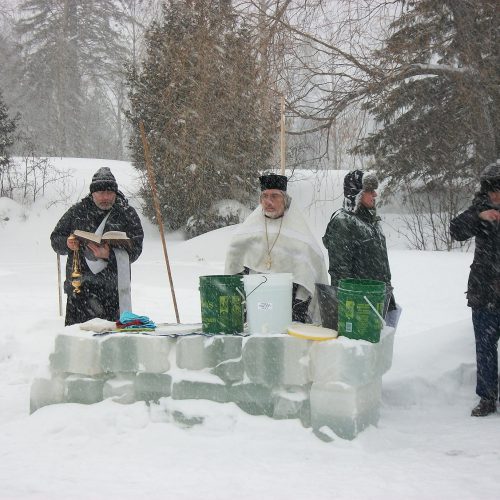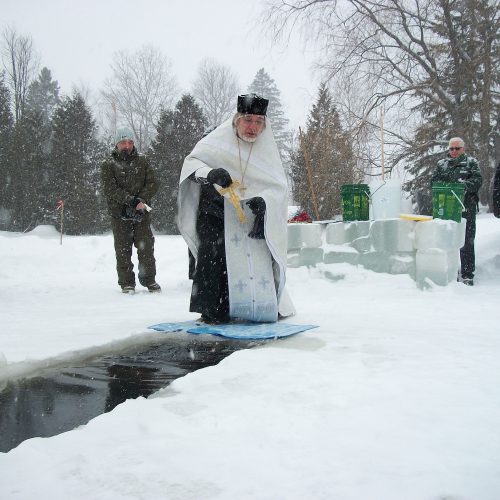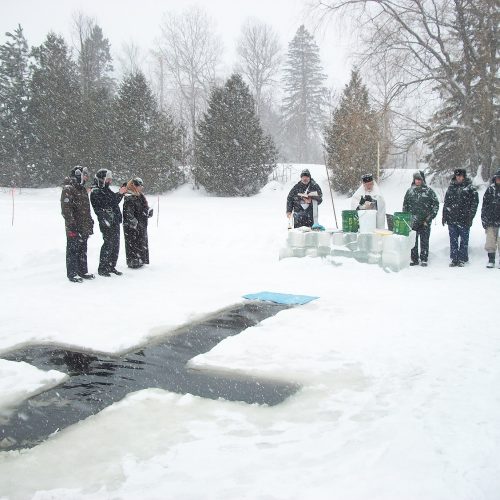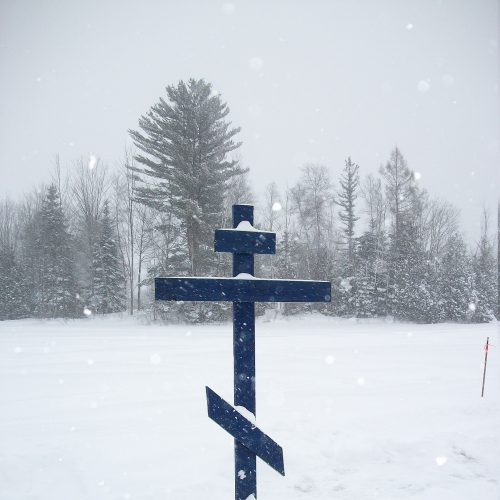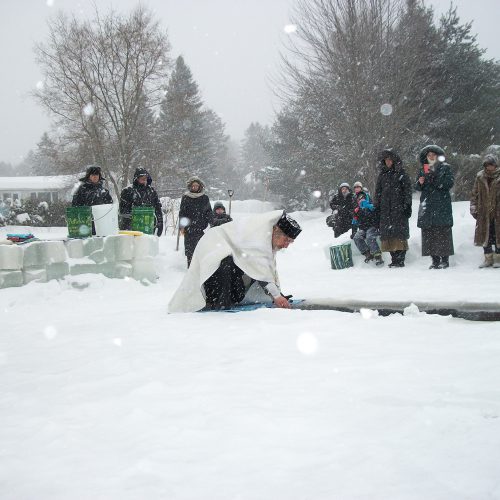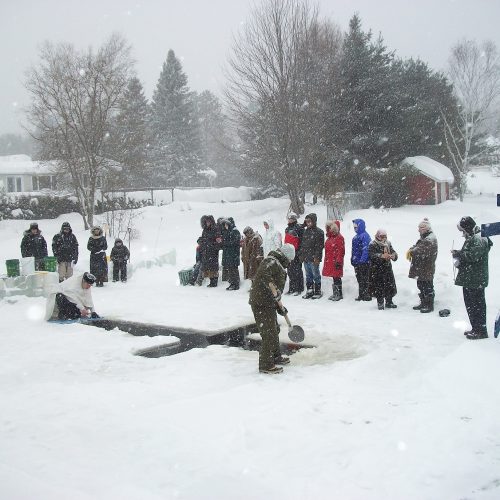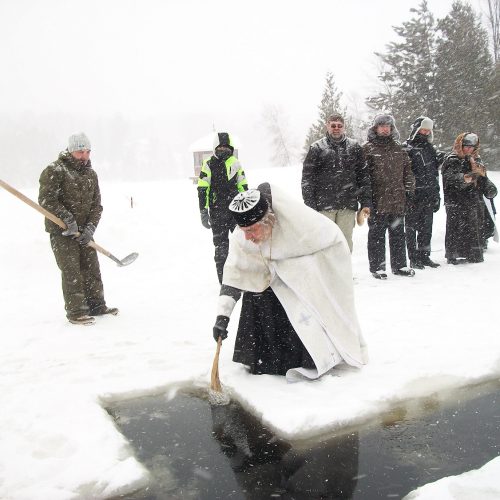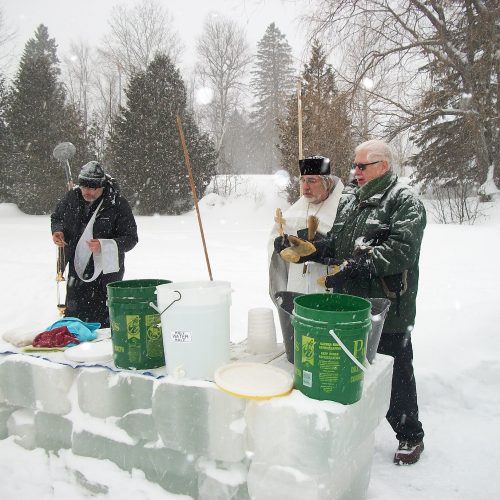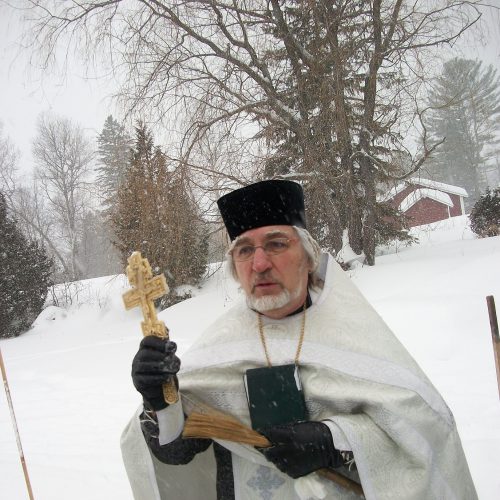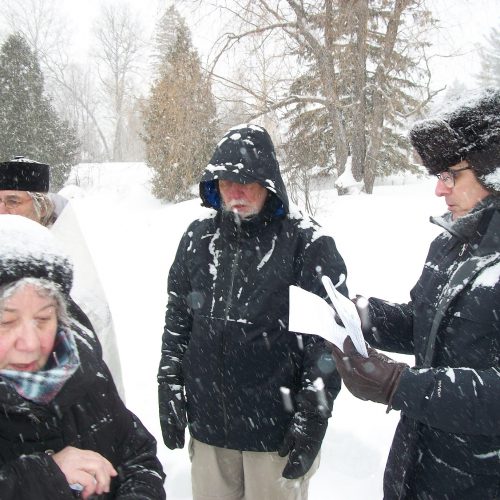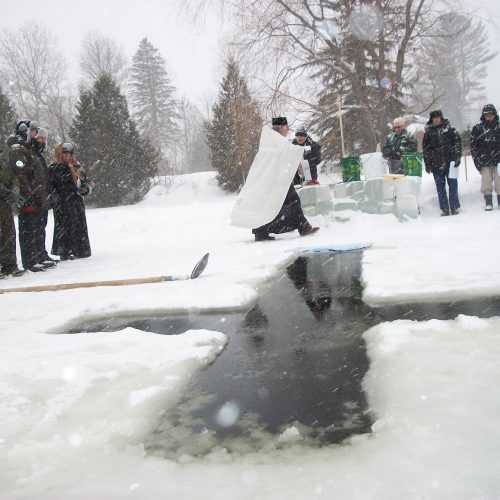News
-

Interview with Archbishop of Montreal and Canada, Gabriel.
31 January 2019
Interview with His Eminence Archbishop Gabriel of Montreal and Canada
– Your Eminence, last year, 2018, was a sorrowful anniversary: the 100th of the murder of the Tsar Passion-Bearer Nikolai Alexandrovich and His August Family. How did the Canadian Diocese mark this event?
– Last year, Historical Russia, that is, all of Orthodox Rus in the Fatherland and the Russian Orthodox diaspora, marked the 100th anniversary of the memory of the martyrdom of Emperor Nicholas II, His August Family, as well as Grand Duchess Elizaveta Feodorovna and those with them. To commemorate this sorrowful anniversary, all the parishes of our diocese performed molebens to the Holy Royal Passion-bearers on the very day of their wicked execution. In September, at the Church of the Smolensk Icon of the Mother of God in Jackson Point, ON, known locally as “Beryozki,” the construction of the Chapel to the Holy Royal Passon-Bearers was completed: this is the only such memorial to the Russian Tsar, Anointed of God, on the North American continent, which was widely reported on in the press.
As late as May of last year, I visited the construction site and consecrated a new cupola and cross that was ordered from Russia, along with a large icon of the Holy Royal Family, which found its home in the new chapel.
Later last summer, fulfilling the instructions of our Metropolitan Hilarion, I was to lead a pilgrimage to the holy sites of Russia. The pilgrimage started in Ekaterinburg, where the Royal Family was martyred, the landmarks Ganina Yama and Alapaevsk, where St Elizabeth met her death. In Ekaterinburg, we were fraternally welcomed by Metropolitan Kirill of Ekaterinburg and Verkhoturiye, who spared no effort to help us visit these holy sites. With Divine aid, I was able to celebrate Divine Liturgy together with Vladyka Kirill in the main monastic church dedicated to the Holy Royal Passion-Beareres (known as the “Royal Church”), at Ganina Yama. The Monastery of the Holy Royal Passion-Bearers is among the newest in all of Russia, and includes seven churches, numbered in accordance with the members of the murdered Royal Family.
Finally, at the end of November, 2018, during our diocesan pastoral conference in Toronto, at Holy Trinity Cathedral, we concluded the celebration of the year of the Holy Royal Passion-Bearers. Divine Liturgy was combined with the service to the Holy Royal Martyrs. Professor Protopriest Georgy Mitrofanov of St Petersburg was specially invited to our assembly, who presented the attendees with an unusually interesting and fact-filled lecture on the fate of the Royal Family and the Russian Church in that difficult time. Fr Georgy’s speech was also delivered to the parishioners of Holy Trinity Cathedral on Sunday, November 18.
Our Holy Trinity Cathedral in Toronto has developed a special tradition of celebrating the “Royal Days.” Back in September, 2013, we marked the 400th anniversary of the Romanov Dynasty. The same month of September, a session of the Synod of Bishops convened. The rector of the Toronto parish, Mitred Protopriest Vladimir Malchenko, Dean of Eastern Canada, submitted an appeal on behalf of his parish. By Divine mercy, Holy Trinity parish in Toronto is probably the biggest in the Russian diaspora. Incidentally, Her Imperial Highness Grand Duchess Olga Alexandrovna Romanova, the sister of our last Tsar, found her final resting place in Toronto. Next year, in 2020, will mark the 60th anniversary of her repose.
– In that case, Vladyka, allow me to ask: you are a descendant of the “first wave” of Russian émigrés. What do you remember from your childhood and youth—what did your parents say about the Royal Family, what did you hear from your elder contemporaries?
– More memorable than words were portraits: those of the Tsar, the Empress, the entire August Family. I saw them in our home and in the homes of our friends. It is significant that within our emigration, the number of conscious admirers of the monarchy was at first small, simply because, in pre-Revolutionary Russia, the number of monarchists was admittedly small among all the classes, but especially the intelligentsia, or those who considered themselves as such. But by Divine Providence, many, many Russian people, after living abroad for years, abandoned the “progressive-liberal” fallacies of the intelligentsia. This represented a return to our roots of practically everyone, and all this began with a return to the embraces of the Church, the self-recognition as Russian Orthodox Christians. For sadly, many only came to the Church after being exiled. They rushed to the Church to escape from their troubles, out of sheer spiritual need. And if one is to judge by the sentiments of the “second emigration,” something similar was happening in those years in Russia itself.
People gradually began to sense their loss, the deprivation of genuine values. This cannot have been a coincidence. Even in the 1950’s, long before the glorification of the Royal Martyrs, on July 17 (new style), in accordance with the decision of our Synod of Bishops, the day of the execution of the Righteous Tsar Emperor Nicholas II Alexandrovich and His August Family, was a day of strict fasting and pannikhidas throughout the diaspora in memory of the Anointed of God. This was a day of mourning for the Russian emigration. The Russian Church Abroad considered the murder of the Tsar and his August Family as Divine punishment meted upon us for the inherited guilt of indifference. The perception of the events of March-October 1917 and all that followed was that they were not simply the result of an unsuccessful temporal policy which could not find in the nation the strength to fight against the machinations of external and internal enemies of our Fatherland, but Divine punishment for the nation-wide apostasy from the Divinely-placed Sovereign. Naturally, there were mistakes made, there were conspiracies: a “hybrid war,” as they say now, was being waged against Russia. The journal of the Royal Passion-Bearer Nikolai Alexandrovich, includes a passage that all around him were “betrayal, cowardice and deceit.”
But it is important to understand that we Russians, precisely due to having abandoned the will of God, could not avoid these errors. We could not find the strength within ourselves to resist the conspiracies and “hybrid warfare,” because we neglected Divine will and rejected the Anointed of God, and the Lord, so that we would see the light, withdrew from us. That is why the haters of Orthodox Russia were able to take advantage of our weakness. The “Restrainer” was taken from us through our own fault.
The Abbot of the Russian Church Abroad, Metropolitan Anthony (Khrapovitsky) of blessed memory, “an exceptional patristic phenomenon,” as the renowned Serbian theologian, Archimandrite Justin (Popovic), called him, spoke the following prophetic words in 1905: “Now, when the revolt is sparking open outrages, when the entire Russian land is being brazenly choked by its pranks, when they spit in your eye, o dear Russia, our hearts are now filled with shame and repentance. Now we understand how we needed to preserve you, our Tsar…” One can’t help but think: was this “now” uttered over a century ago, and not yesterday and not today?
– The same year, 2018, marked the 100th anniversary of the beginning of the internecine Civil War in Russia. Can we agree that among the Russian people, reconciliation has taken root, that is, the mutual wrath of the Civil War has finally, thank God, receded into the past, or is it still in the process of receding?
– By my observations, there is still a lack of understanding in Russia about what happened to us, to our people. This misconception stretches from top to bottom. It’s as if we cannot make room for the truth. The people of Russia, a majority, are properly indignant about the actions of the collective West with regard to our Fatherland; sanctions, the flood of fake news, the constant attempts to “restrain” Russia, and finally attempts to overthrow the government. But these same forces over the course of many long decades tried to destroy Tsarist Russia, to defile the Divinely-appointed Anointed of God, destroy Russian Civilization.
It is no accident that in St Petersburg, after the February Revolution of 1917, it was rumored that the Prime Minister of Great Britain, Lloyd George, having learned of the forced abdication of the Tsar, rubbed his hands together and said “One English goal in this war has been accomplished.” The events of that October were in my opinion a direct continuation of February’s events. The prototypes described in Dostoevsky’s book Devils came to power in our Fatherland, which fully corresponded with the aims of the enemies of Russia.
Remember how before the First World War, all the exceptional economic indicators in Russia pointed to her coming power and greatness. We know what happened a short three years later. The Second Time of Troubles came to Russia, which proved more horrible and longer than the first, which had ended with the election of Mikhail Romanov to the Throne. The Second Time of Troubles swept away millions and millions of Russian lives. Whatever we call these terrible events—repressions or “the consequences of the Civil War of the elites,” the essence of those events remain unchanged: a new regime, atheistic, with a satanic hatred of the Orthodox Church, brought Russia immeasurable catastrophes and sufferings.
I recall the prophetic words spoken by Metropolitan Anthony in 1905. The hierarch warned that if the Divinely-appointed Royal regime is shaken, then the people “will be the sorriest of nations, enslaved by the enemy of all her holy and dear pillars of her thousand-year history, by a persistent and brutal enemy, who will begin by depriving us of learning the Law of God in schools, and will end with the destruction of holy churches and the discarding of the relics of God’s saints, gathering them in anatomical museums…” That is precisely what happened. The godless regime, with all its cruelty, remained blind and deaf. Even the Russian victory in World War II (the Great War of the Fatherland) taught the regime nothing.
But external forces hostile to Russia understood that the danger of the Russian rebirth was still a reality, which meant that the destruction of our Fatherland must continue. By the final decade of the 20th century, Soviet Russia seemed to become a genuine superpower. But some two or three years later, the Third Russian Time of Troubles arrived. In order to overcome it, the old process of fragmenting our historic self-identity had to be overcome. If we are indignant today at the external efforts to achieve regime change in Russia through “technologies,” then we must admit that 100 years ago, practically the same thing was taking place, consequently, we must condemn the internal forces that led to the Russian Time of Troubles of 1917-1918.
It would seem that we all want a strong Russia. But this might be impossible to achieve if we don’t grasp what happened to us. When we speak of the Soviet epoch, one often hears: “That was our history!” Absolutely correct. But this period in our history remains to this day not fully understood. It is sad to say that the podvigi of our Holy New Martyrs of Russia are not fully internalized. The files of many of them who have not yet been glorified remain in archives, which are sealed. The reason, we are told, is so that the descendants of those who were the de facto executioners of the New Martyrs would not be troubled and insulted. This for me is completely unacceptable. I propose that all such files should be opened, and the descendants of those who committed the grave acts should be called upon to pray for the forgiveness of their unfortunate ancestors before the Lord, Who “lifts up the fallen and elevates those who are cast down.” Much can and should be done in this area, both by the government and by the Church.
– Let’s talk a bit more about anniversaries: but now your personal ones. Ten years have passed since you were appointed to the Canadian Diocese. Can you give us an overview: what has changed in the diocese entrusted to you over this time, what has been accomplished, what remains ahead?
– I was assigned by the Synod of Bishops to minister to the Eastern Deanery of the Canadian Diocese in December 2001 while remaining Bishop of Manhattan. But when I was given the cathedra of Canada, I began to understand what happened there, what the reason was for the troubles and conflicts. For instance, here, due to the fire of the winter of 1998 the magnificence of St Nicholas Cathedral was reduced to burnt walls. Today, 20 years later, though reconstruction continues, thank God, we have a place to pray together. Though frankly, we still do not have a real iconostasis… We rely on the help of God. Very recently, after many years of effort, we managed to establish a candle factory. At one time, the revenues of the Canadian Diocese were based on the traditional candle business, and so we rely on that resource today. Unfortunately, our diocese no longer has a working monastery, but by Divine will, new monastic communities will be formed. At the same time, the number of parishioners is growing, first of all due to the newly-arrived immigrants from Historical Russia, and so the number of parishes is growing: the Parish of St Tikhon of Moscow the Confessor in Cambridge, ON; Holy Prince Vladimir, Equal-to-the-Apostles Church in Saskatoon, Saskatchewan, which never had a Russian Orthodox community before; and St John of Shanghai and San Francisco Church in Calgary, AB. The small, so-called “summer” community of the Church of the Smolensk Icon of the Mother of God in Jackson Point, ON, thank God, has multiplied and has become a big, growing parish. We try to live in peace with one another. When it comes to property conflicts, during which great funds were expended by the once-wealthy Canadian Diocese, we no longer turn to civil courts but seek out peaceful paths appropriate for Orthodox Christians.
– What is your opinion of the events surrounding the granting by Constantinople of so-called “autocephaly,” which the hierarchy of the canonical Ukrainian Orthodox Church did not even request? Are the actions of the Phanar purely political, that is, non-ecclesiastical, or even anti-ecclesiastical?That is precisely, in my opinion, the way we should view these actions. This not simply a violation of order which disrupts the Church, but simply the trampling on of the Holy Canons, going far beyond all bounds. His Holiness Patriarch Kirill recently called the actions of the Phanar “political adventurism,” and His Beatitude Metropolitan Onouphry noted recently that this “new ecclesiastical structure” is actually a political party which will not last. The crisis lies in the fact that a centuries-old canonical order is being threatened. This may bring suffering and blood to the ancient land of Kievan Rus. Comprising this “Orthodox Church of Ukraine,” created by demand for political ends, are only schismatics, and, thank God, not many traitors to the true Church. It is difficult to refute the opinion that in “restoring” the anathematized former Metropolitan Philaret Denisenko, Patriarch Bartholomew himself is subjected to anathema.
“The thousand-year-old Ukrainian Orthodox Church is not only recognized by the entire Orthodox Christian world, but the ‘Philaretites,’ autocephalists and the Ukrainian state itself recognizes her as the Church of Christ, her Mysteries being salvific and grace-filled. So why, one asks, are they blaspheming her, insulting her, provoking physical attacks on her? How will these hateful, lying, blaspheming Poroshenko, screaming ‘death to our enemies’ and Patriarch Bartholomew cobble together a new Church of Christ, a Church of salvation, love and brotherhood?” These are the words of Vasily Semenovich Anisimov, Head of the Press Service of the Ukrainian Orthodox Church. “The Russian Orthodox Church is seen by the UOC as its mother,” he continued. “Her dioceses, beginning in the 20th century, formed the Ukrainian Exarchate, and in 1990 transformed her into an autonomous (independent) Church, giving her the name ‘Ukrainian Orthodox Church,’ granting her a tomos (decree) of independence and self-governance. All the dioceses of the ROC which are on the territory of the Soviet-era Ukraine are part of her, lands both ancient and those joined to the Russian Empire, and later the USSR. The Constantinople Patriarch has no relation to Ukraine, nor the Ukrainian Orthodox Church, since there was no such state nor such a Church three hundred years ago (since 1686, when the Kievan Metropoliate became, under Patriarch Ioakim, a part of the Russian Orthodox Church). In 1991 the future Patriarch Bartholomew was in Kiev, and enumerated the reasons why our autocephalists are apostates and criminals and lead the people to Hell. When Metropolitan Philaret departed into schism and created his own schismatic UOC/KP, Bartholomew declared that there is no such institution in Orthodox Christianity, and that no one considers Philaret a bishop. Now he has to somehow wiggle out of it and explain why the very same people who were deceitfully leading people into Hell, to eternal damnation, are now are guides to the Kingdom of Heaven.”
What Anisimov said needs no further clarification. I would only add that for us in the Russian Church, such actions by the Patriarchs of Phanar are by no means new. Back in 1924, under Gregory VII, the Phanar demanded that His Holiness Patriarch Tikhon the Confessor immediately resign from ruling the Church and recognized the Synod of the “Obnovlentsy” [Renovationists] and proposed to the Serbian Patriarch Dimitry that he shut the Synod of Bishops of the Russian Orthodox Church Outside of Russia, which at that time was located in Serbia. Measures were taken against the Russian bishops living in Istanbul at the time: Archbishop Anastassy (future Primate of ROCOR) and Bishop Alexander of North America. They were suspended from clerical service, commanded to cease commemorating Patriarch Tikhon, and advised to acknowledge the legitimacy of the Soviet State. The pitiful history of the Constantinople (Ecumenical) Patriarchate over the last century continued, but we could also turn to the times of the Brest Union of 1596, when several bishops of the Kiev Metropoliate of the Constantinople Patriarchate, headed by Metropolitan Mikhail Rogoza, accepted the Catholic version of the faith and moved to the jurisdiction of the Roman pope while preserving the “Eastern rite” of divine services.
But the matter lies not in individuals and their weaknesses and sins, from which bishops are not exempt. One remembers the second chapter of Apocalypse (Revelation of St John the Theologian), which speaks of the seven local Churches in Asia, at one time grand and glorious, but by Divine providence disappearing without a trace. The One Holy Ecumenical Church is eternal, though her temporal life is subject to the laws of temporary existence. Observing these events, one cannot but ask: Does the Ecumenical Patriarchate of Constantinople still exist in the world if it disappeared along with Byzantium? Do we not mistake her for a dubious “ecclesiastical structure” which for so many years has been selling geopolitical services in the world market? Obviously only an Ecumenical Council can seek answers to such questions. Meanwhile, we must not forget the words from Revelation: “He that hath an ear, let him hear what the Spirit saith unto the churches; To him that overcometh will I give to eat of the tree of life” (Revelation 2:7).
In these troublesome days for the canonical Ukrainian Orthodox Church, I would like once again to express our support for her lawful Primate, His Beatitude Metropolitan Onouphry, and his suffering flock, which is called upon to “uphold as her cross,” as St John of Shanghai and San Francisco once said, true Orthodoxy on the ancient lands of Kiev and Galician Rus.
(Translation by Nicholas A Ohotin)
-
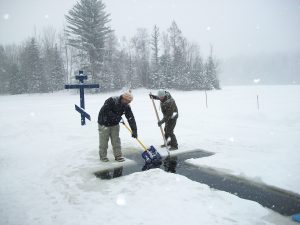
-
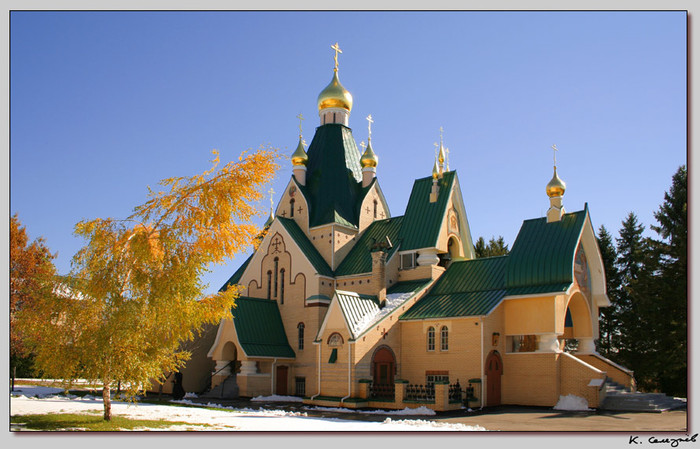
Decree of plate collection for the needs of Holy Trinity Orthodox Seminary in Jordanville.
29 January 2019
DIRECTIVE
To the Reverend Rectors, Clergy & Parishioners
Of the Diocese of Canada
You are hereby reminded that, in accordance with the decision reached and confirmed by
the Synod of Bishops of the Russian Orthodox Church Outside of Russia, on one of the Sundays
closest to the feast day of the Synaxis of the Three Holy Hierarchs, which is celebrated on 30
January/12 February 2019, a special plate collection is to be taken up in all the churches of our
Diocese for the needs of our Holy Trinity Orthodox Seminary, in Jordanville.
It is our sacred duty to prepare educated pastors in our Seminary, and—what is especially
important today—without encumbrances. Each of us should, to the utmost of his abilities, take up
this task with diligence.
As you have been reminded more than once, the reverend rectors should watch their young
parishioners, since it is possible that some of them may show a readiness to study in our
Seminary, so as later to take up the obedience of priests.
I order the reverend rectors to make the aforementioned collection on Sunday, February
10, preceding it with an edifying sermon appropriate to the occasion, addressed to the
parishioners, reminding them of the glorious history of our Seminary and the very important role
it plays in our most difficult times.
Gabriel,
Archbishop of Montréal & Canada
03/1/2019-CA
January 11/24, 2019 -
-
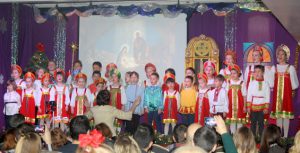
-

-
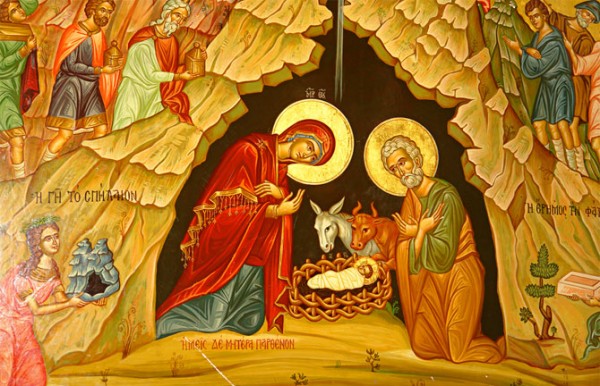
Nativity Epistle of His Eminence Metropolitan Hilarion of Eastern America and New York, First Hierarch of the Russian Orthodox Church Outside of Russia.2019
4 January 2019
NEW YORK: January 4, 2018
Nativity Epistle of His Eminence Hilarion, Metropolitan of Eastern America and New York, First Hierarch of the Russian Church AbroadEminent Brother Archpastors, Honorable Fathers,
My Dear Brothers, Sisters and Children in Christ:Please accept my words of greeting, filled with Christian love, on this great celebration of the Nativity of Christ! With a warm heart I wish you all profound and inalienable peace, heralded by the angels above the town of Bethlehem on that holy night, when “the Word was made flesh” (John 1:14).
With the holiday of the Nativity of Christ comes the New Year. Time flies, year after year, day after day. Commotion, problems, bad news and complicated times instill in us despondency, alarm and fear of the future, distracting us from committing good deeds, attending to our internal life and relying upon the blessed Providence of God, always unerringly directing man towards true joy.
In one passage of the Gospel, the Lord says: “But when ye shall see the abomination of desolation, spoken of by Daniel the prophet, standing where it ought not, (let him that readeth understand,) then let them that be in Judaea flee to the mountains” (Mark 13:14). And King David, whose memory is honored on the Sunday after the Nativity of Christ, cries out: “I will lift up mine eyes unto the hills, from whence cometh my help” (Psalms 121:1). “Come, let us ascend the mountain of the Lord, even unto the house of our God,” we sing in church.
Holy Scripture and its wise interpreters: the successors of the Apostles, the Holy Fathers and Teachers of the Church, always saw in the climbing of a mountain the spiritual elevation of man towards God, his active striving for unity with Him, and holiness. The peak of the mountain and the “house of our God” symbolizes the Kingdom of God, the Church of Christ, the place of the living God and His abode with mankind. This is the world of the spirit, of spiritual joy and true bliss in unity with God. Here is our native and blessed land; here is the resolution of all problems which trouble the inner man; here is the eternal salvation of the soul.
Brothers and sisters, observing world events, let us not fall into despair, alarm and fear, but hasten in a spiritual sense “up the mountain,” so that, girding ourselves with humble gratitude for everything that God sends us, with staff in hand, begin our ascent “to the mountain of the Lord.” Let us to the best of our feeble powers strive for God, uniting our active effort in living by the Gospel with our immersion into the wisdom and the mystical life of the Church, this school of piety, Christian virtues and sanctity, paying no heed to that which distracts us from “the one thing needful” (Luke 10:42).
It is not revealed to mankind what might befall us over this year. But that is for our benefit and edification. For if man knew in advance of the coming joy, he might resort to complete idleness, making no progress in becoming able to worthily receive the gift of God; at the same time, knowing in advance of his necessary sufferings would be too great a burden. That is likely why the Lord secretes our future from us, teaching us to hope in His Providence, faith, patience and humility.
Upon this difficult but blessed path let St John (Maximovich) be our intercessor, this great achpastor and miracle-worker of the Russian diaspora, the 25th anniversary of whose canonization we will be ceremoniously marking in 2019.
I will conclude my greeting to you with his words: “To the Lord lying in a manger, together with praise and laudation, may each of us bring from our heart some good deed. May the joy of the whole world fill the hearts of each of us, scattering earthly sorrows and lifting up our thoughts and strivings to Heaven. From there we hear the joyful herald of the angels: “For unto you is born this day… a Saviour, which is Christ the Lord” (Luke 2:11).
With love in the Born Christ,+HILARION
Metropolitan of Eastern America and New York,
First Hierarch of the Russian Orthodox Church Outside of Russia. -
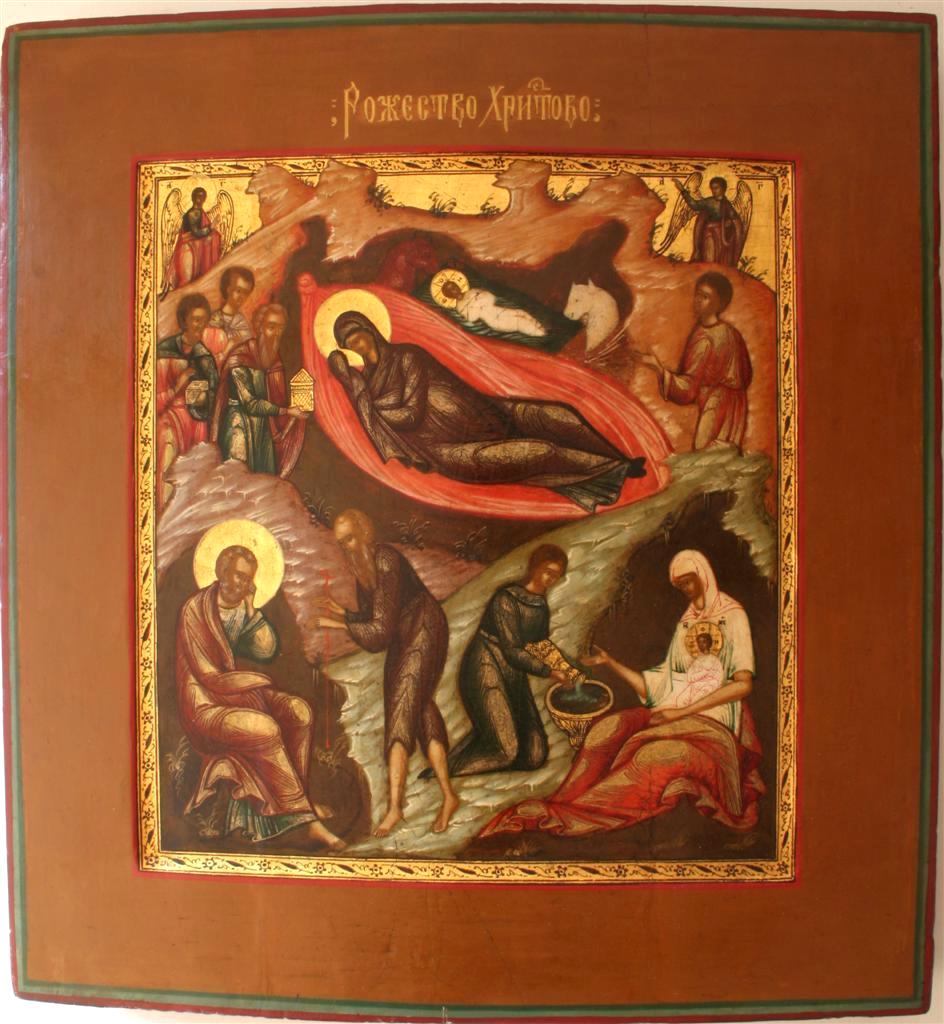
Nativity epistle of His Eminence, Archbishop Gabriel. 2019
3 January 2019
The Most Reverend Archbishop Gabriel
of Montreal and CanadaCHRISTMAS EPISTLE
To the clergy and God-saved flock of the Diocese of Canada
Beloved brothers and sisters in Christ!“Christ is born – glorify Him!” – the Orthodox Church sings, and we, Its children, start singing together with It forty days before the Feast of the Nativity of Christ: “Christ is on earth – lift up your hearts!” Yet the world, full of enmity, envy and malice among men even in the day when God and Infant Christ was born, seemed not prepared to Christ’s coming on earth. Only a small flock was deemed worthy to receive Him: His Most Holy Mother, Theotokos and Ever-Virgin Mary, humble shepherds of Bethlehem, the wise men from the East, who enquired about the star of the King of the Jews in Jerusalem, and came to worship Him, bringing precious gifts.
And yet, despite their wielding temporal power, their perfidy and cunning, those who “sought the young Child’s life” (Mt 2:20) could not alter God’s will for the Salvation of mankind. The prince of this world’s fight against Christ keeps on going before our very eyes. Last year we remembered one hundred years since the new herodian massacre of the innocents – the murder of the Imperial Family, of their innocent children. This evil deed brought about countless woes, not only for Russia, but for the whole world, including those who, directly or indirectly, were involved in this terrible crime.
One could say that the salvific event of Christ’s Nativity was accompanied by intermingling of joyous and sad feelings and premonitions. Hence the sign of a scroll that was given to the prophet, with “lamentations, and mourning, and woe” written within it, but that scroll was as sweet as honey in prophet’s mouth (Ez 2:10 and 3:2). And this goes on even today. Thus now we are witnessing attempts of the servants of the prince of this world, who follow in Herod’s footsteps, to vanquish the Church of Christ in the ancient land of Kievan Rus. Yet let us recall the words of one of the great predecessors of His Beatitude Onuphry, Metropolitan of Kiev and All Ukraine – His Beatitude Anthony, Metropolitan of Kiev and Galicia, Abba of the Russian Church Abroad: “Believe me, my beloved, that this very poverty and want which may be throwing your souls into despair, in the future (especially for those whom God would grant to live to see the days of joy) will become a source of comforting reminiscences and a cause of kind feelings towards each other”.
In the days of Christmas, the Orthodox Christians, giving glory to Him who became a cornerstone for these great events, try to bring joys to each other, no matter how small. These joys remind people of the great spiritual joy of God’s grace that was sent down to us from the manger at Bethlehem. That is why the Church, in the hymns of the Feast of the Nativity of Christ, reminds us of the meaning of the greatest event in the salvation of mankind – God coming down to earth as a Babe: “A strange and most wonderful mystery do I see: the cave is heaven; the Virgin the throne of the cherubim; the manger a room, in which Christ, the God whom nothing can contain, is laid. Him do we praise and magnify”.
CHRIST IS BORN! GLORIFY HIM!GABRIEL
Archbishop of Montreal & Canada
Nativity of Christ, 2019
